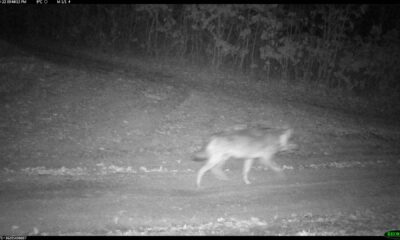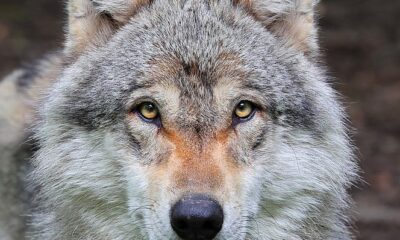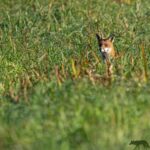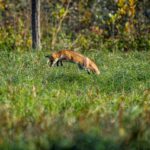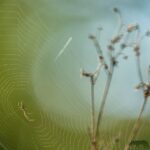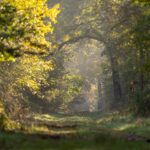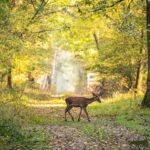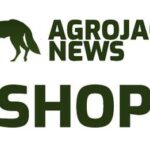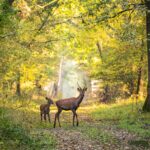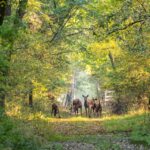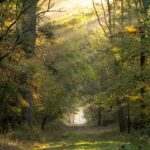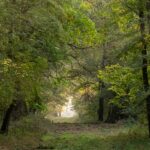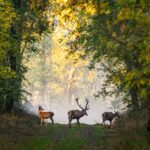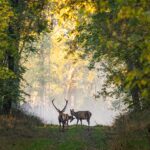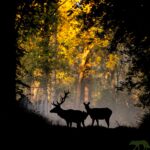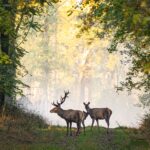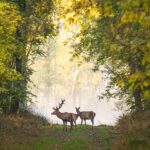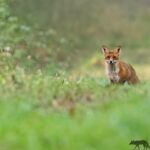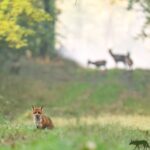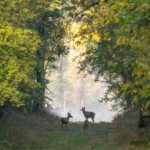Nature protection
Looking back: Big carnivore synchronization in the area of the Bükki National Park Directorate – with Gallery
Specialists of the Bükki National Park Board assessed the gray wolf population in 2020
Bükki National Park Directorate : On 01.30-31.2020, the nature protection guard service of our directorate carried out a coordinated survey. During the synchronous counting involving the territory of the three counties (Nógrád, Heves, Borsod-Abaúj-Zemplén), we traced and examined a total of about 425 kilometers of routes in search of traces of wolves and lynxes. A total of 18 people participated in the survey, the work of the 16 nature conservation guard colleagues was assisted by our “civilian” colleague in Nógrád County, while in the Tarna-Lázbérc Landscape Unit, an external volunteer helped.
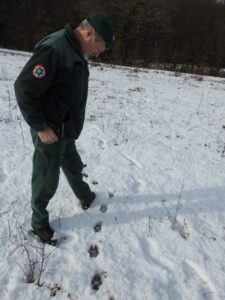
Following a wolf on the Nagyragadozó-Sinkron (András Kleszó – Bükki National Park)
The Nógrád -Ipoly Landscape Group, the Mátra Landscape Group, the Tarna-Lázbérc Landscape Group, the Nyugat-bükk Landscape Group and the East-bükk Landscape Group participated in the Nagyragadozó-Synchron.
In recent years, it has been proven that all three of the large carnivore species living in our wider region occur, and the wolf and the lynx have permanently settled in the territory of the Bükki National Park Administration. The former has multiplied successfully several times, while in the case of the latter, although this can also be taken for sure, for now we can only speculate.
The bear appears rarely, irregularly, mainly during its wanderings, but its tracks can be found more often in our areas bordering Slovakia.

Track of a lynx (Gábor Domboróczki – Bükki National Park)
We are therefore beyond the scope of proving their presence and occurrence. Regarding the wolf, in the future, in addition to the processing and evaluation of the large amount of data that has already been collected, the kinship relationships of the individuals, the social networks and the examination of their territory use on a finer scale should come to the fore.
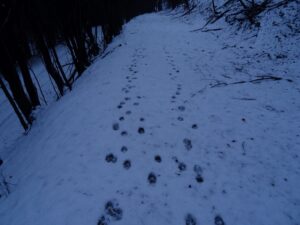
Tracks of a pack of 5 (Illyés Evelin – Bükki National Park)
It will also be important to examine how the wolves appearing in the BNPI territory have a living relationship with the neighboring herds that live further north, the source stock in the highlands (since the wolves that re-occupied the territories of our Directorate came from there, and new individuals may arrive today as well).

Photo: András Kleszó – Bükki National Park
In order to achieve the above-mentioned goals, the Nature Conservation Service of the Bükki National Park Directorate regularly monitors the presence of resettled/resettling large carnivores and collects information about highly protected species. This work is carried out with the help of colleagues from the Nature Conservation Department. The special period for collecting information is winter, when (ideally) thanks to the snow cover, we can more easily find the tracks of large predators, following them we can make many new observations and increase our knowledge. The observations we make during the investigations are well controlled, and the data collection is very effectively supported by the network of camera traps operated in the field.

Wolf trail in Bükk (Róbert Juhász – Bükk National Park)
The basic conditions for the effective implementation of the synchronization are that the colleagues can participate in it in the right weather conditions and in the right number of people. Since large carnivores can cover long distances in a single night, we cannot “give them” too much time before starting the survey after a fresh snowfall, because the chance of counting the same individuals in parallel, even in distant areas will significantly increase, resulting in false numbers. (we may overestimate the stock). However, “not giving them” enough time is also a bad solution. After snow that lasts until the morning, it makes no sense to carry out a survey that day, because there will most likely be no fresh tracks. It is therefore difficult to “catch” the right time and to react quickly in a large area with the right number of people.
In January 2019, we already tried to carry out a coordinated, synchronous field survey, but it snowed almost until noon on the designated day, making a successful investigation impossible. This year, the opportunity arose for the first time at the end of January 2020, thanks to the snowfall on 01.28, which temporarily covered Northern Hungary with a uniform blanket of snow, and despite the short time available, it was organized and implemented. This is how the Big Carnivore Synchronization took place on 30.01.2020-31.01.2020 , which was considered the first complete synchronization in the history of the Board. We also had preliminary information at our disposal, since right before the snowfall, the colleagues found tracks and remains of prey, camera trap recordings were made, and on 01.28 news came about a wolf pack alerted in a drive during a Bükki hunt, which reported the sighting of 11 wolves!
In our opinion, the survey can be said to be successful, because documented occurrences of large carnivores were found in each landscape unit! In most cases, this has become certain on the basis of traces of life (footprints, excrement, or prey remains) created since the beginning of the snowfall, as well as the recordings of wolves taken by camera traps that confirm them. Wolves occurred in all affected landscape units, lynx was found only in the West Bükk Landscape Unit at the time of the synchronization.
Footprints of lone wolves were found on the Medves Plateau and Mátra, while a five-member wolf pack homesteaded in the Tarna region.
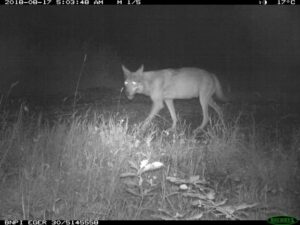
Photo: Bükki National Park
In the Bükk, the Fennsík and in the southern block of the mountain range, we experienced the activity of wolves in markedly different areas during the synchronization. Based on these, we estimate the number of wolves in Bükk to be 9-11 individuals. The difference between the minimum and maximum values results from the fact that it is not always possible to 100% rule out movements between individual areas, and that the herd of 11 members detected before the synchronization probably split up several times, so it was not possible to determine this number of individuals with absolute certainty. confirm.
Summarizing everything, the final result of the synchronization projected onto the potentially large carnivore areas of the Bükki National Park Directorate: 15-18 wolf individuals and 1 lynx were counted during the survey!
Source: Bükki National Park Directorate
Hunting
Vadászat fényképezőgéppel: Retkes Tamás Gemencből jelentkezett – GALÉRIA
 Nagyon vágytam már az erdőbe, mert utoljára szeptember közepén jártam kint. Azóta folyamatosan vadásztak, így nem tudtam fényképezni. Most, 23-án, végre sikerült összehozni és nagyon jó mozgás volt. Reggel, már napkelte előtt kimentem, hogy az első fényeknél fényképezzek. Az egyik nyiladékon, a távolban, egy spíszer bikát vettem észre, majd egy tehenet és borját pillantottam meg, ahogy átváltanak előttem.
Nagyon vágytam már az erdőbe, mert utoljára szeptember közepén jártam kint. Azóta folyamatosan vadásztak, így nem tudtam fényképezni. Most, 23-án, végre sikerült összehozni és nagyon jó mozgás volt. Reggel, már napkelte előtt kimentem, hogy az első fényeknél fényképezzek. Az egyik nyiladékon, a távolban, egy spíszer bikát vettem észre, majd egy tehenet és borját pillantottam meg, ahogy átváltanak előttem.

Aztán, ahogy fotóztam őket, egyszer csak egy vörös róka jött be a látómezőmbe. Gyorsan ráfókuszáltam, hogy az előtérben a rókát lássuk, miközben a háttérben a szarvasok figyelnek.
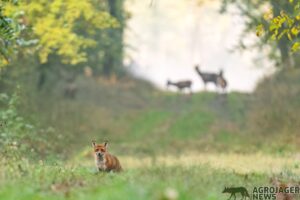
Sikerült is jó pár fotó, ahogy közeledik felém a róka. Aztán egyszer csak a bal oldalról még egy szarvasbika váltott ki, a háttérben álló a szarvasokkal. Ekkor visszaálltam a szarvasokra és készítettem megint pár fotót.
Mikor továbbindultam, nagyon jó fények fogadtak és gyönyörű volt az őszi erdő, állatok nélkül is. Így készítettem pár ilyen fotót is.
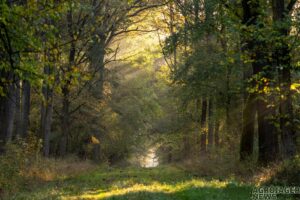
Egy másik nyiladékon, jobb oldalról, fiatal bikák, spíszerek és tarvadak borjaikkal váltottak újra ki és legeltek előttem, ahol megint csak több fotót sikerült lőnöm róluk. Innen továbbsurrantam és megint egy szép erdőrészletet örökítettem meg , majd arra lettem figyelmes, hogy több pókháló csillog a reggeli fényben. Így egy kicsit megálltam ezeket is fotózni.
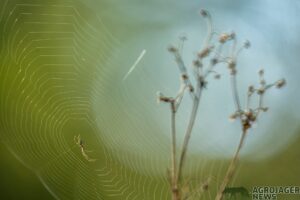
Már kifelé vettem az irányt, mikor egy nagyobb tisztáson, a nagy fűben, egy róka vöröslött már messziről. Gyorsan közelebb cserkeltem és lőttem pár fotót, ahogy éppen a reggelijét kereste. Persze, vadászott. Ezek után még egy szürkegémet, hattyúkat és egy kárókatonát örökítettem meg.
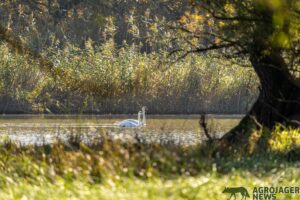
Végül dél körül értem ki az erdőből. Visszaindultam az autómhoz és örültem, hogy ennyi mindent sikerült fotóznom.
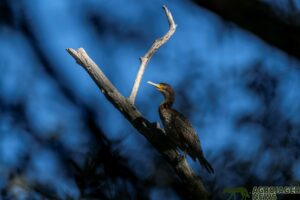
Jól esett a 18 000 lépésszám körüli séta, a cserkelés is, hogy friss levegőn lehettem, messze az emberektől, kiszakadva a város nyüzsgésétől. Így ez a hét, kedden úgy indulhatott, hogy feltöltődve tudtam munkába állni!
Írta és fényképezte:
Retkes Tamás természetfotós
Nature protection
The spring bird migration is coming to an end
The spring bird migration is slowly coming to an end
The borders of the Körös-Maros National Park have been busy with birds for weeks. The spring bird migration is slowly coming to an end. The species that winter here but breed further north than us have set off, and those that nest here have returned from their long migration.
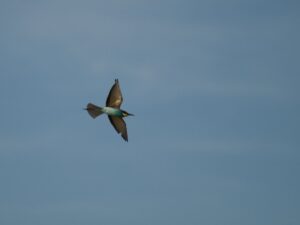
Photo: Gyurgyalag. Balla Tihamér – Körös-Maros National Park
In the second half of April in the Kígyósi plain, we could barely meet duck species that winter but breed further north. However, the ducks that breed here have come. The situation is similar for birds of prey, the winterers have left, and the blue terns, goshawks and gray grebes have arrived. We are still waiting for our songbird, the small warbler, which will return at the latest, usually at the beginning or middle of May. Among the shorebirds nesting further north from us, we saw a few more mountain sandpipers and shield terns in the last week of April. The vast majority of our birds have arrived by the end of the month, chickadees, great gobies, red-footed wagtails, and sandpipers populate the landscape.
The classic spring bird migration is also coming to an end in Kis-Sárrét. There are even more northern guests staying here, but they are slowly moving away. Ashy meadowlarks have recently returned from their wintering grounds, and some specimens are already breeding in the vicinity of last year’s nesting grounds. Smaller or larger flocks of bastard warblers, sooty warblers and white-winged Tern regularly pass through the area. In the past few days, we have observed the first comet herons, and the first specimens of european roller have also arrived. Among the songbirds, the thorn-stinging warblers also just arrived, but an unusually early small guard warbler was also found.
On the Cserebökény steppes, in the middle of March, there were 6,000 chickadees, 2,500 golden plovers, and 4,000 starlings at the water bodies. In addition to the hundreds of pájssoskankó, there were 90 large goda, 66 large pólings and 110 small pólings in the area. From March 20, the storks, gulipans, redshank and the first white and black storks arrived continuously. At the beginning of April, among the species wintering here, we saw five more grebe buzzards, ten blue pied buntings and a large warbler. The blue pigeons that visit the steppes for the winter have been replaced by the returning ringed pigeons. We observed the first swallows on April 3rd, and by April 10th their number had increased nicely. This is when the ashy warblers arrived and the pale warblers marched. In mid-April, the first flocks of blue vultures returned from their wintering grounds in South Africa, and soon after, the european roller also appeared. Yellow thrushes and cuckoos are speaking, and we also saw a small warbler. By April 25, all the migratory birds had arrived, except for the warblers.
Among the shorebirds in the Kardoskúti plain, the migration of the shield-billed grebe was strong even in the last week of April. The peak was observed on April 20, when we counted 1,620 specimens. They were the most numerous of the party birds, after the chickadees and goldfinches. The number of mountain runners is also constantly increasing, so far the highest number was 111, the peak migration is expected at the beginning of May. It is interesting that we also managed to observe some small sandpipers, Temminck’s sandpipers and lake sandpipers joining the mountain sandpipers. By the middle of April, the blue meadowlarks had migrated north and some gray meadowlarks were found. Among the songbirds, the migration of rusty-throated plovers has begun, and in the last week of April, the first thorn-stinging warblers also arrived. The cuckoos have been migrating for quite some time and have been making their voices heard intensively.
Many bird species that spent the winter in the south, even south of the Equator, have also returned to the Makó landscape of the Körös-Maros National Park. In the last week of April, we spotted the first cuckoos, warblers, and warblers of the year. Among the birds of prey, the first blue warblers have just appeared. There are also gray herons in the area, but they only station here and then move on to their breeding grounds.
The spring bird migration on the Dévaványa-Ecseg wastelands was spectacular in previous years, but the situation is different last year and this year. In recent weeks, some bird movement has been barely perceptible. The reason for this is that there was little rainfall, so there are no internal water spots or standing water on the lawn. Every now and then we see a small group of shield-winged warblers, 10-20 golden warblers, some chicks and a single specimen of the later breeding red-legged warblers. Gatherings were spectacularly missed. The warblers have returned to the forests, the warblers and the rusty pike are singing, and the cuckoos can already be heard. The forests are also not as saturated as before: there are fewer gorse, tit, and sable. On the other hand, greater numbers of short-eared owls wintered in the Dévaványa area, and ten pairs had already built nests.
Source: Körös-Maros National Park
Nature protection
Corn buntings are singings in the landscapes of the Southern Great Plains
Corn buntings are singings in the landscapes of the Southern Great Plains
In many places in the Körös-Maros National Park, the characteristic sounds of spring include the song of the corn bunting (Emberiza calandra). The largest domestic sparrow (with a more stocky appearance than a sparrow) can be seen and heard mainly in agricultural areas.
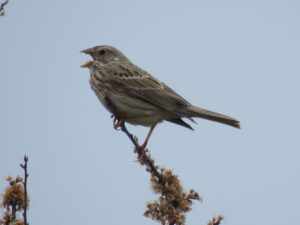
Photo: István Biró
Its song sounds more like a rough chirping, which it mainly hears from a protruding place, the top of a bush, some kind of post, stake, or perhaps a stronger plant stem.
The main characteristic of the bird is that experts consider it a so-called indicator species. Indicator species have special environmental and ecological needs, so the size of their stocks reflects the favorable or unfavorable changes in the given area. Another important feature of the indicator species is that it is easy to recognize, easy to determine, and its appearance cannot be confused with other species, so even the lay observer has a good chance of recognizing it. The size of their holdings can therefore be estimated and calculated more easily.
Are you looking for reliable binoculars? Click on the picture!
Based on its habitat requirements, the gorse can primarily be associated with extensive, extensively cultivated agricultural areas, where a diverse habitat structure, fields, lawns, shrubs, and weedy patches can all be found. In these places, the use of chemicals and fertilizers is minimal, thanks to which a rich supply of food is available to the sorrels. In Hungary, too, it is mainly found in the flat and low hilly areas where the listed characteristics are typical.
It spawns twice a year, laying three to six eggs. It builds its nest close to the ground, under bushes or in dense vegetation. It is mainly insectivorous during the budding period, but except for this period, its food consists of various seeds, mainly weed seeds. It only migrates to the southern regions during harsh winters, so in the mild winters of recent years, we could meet it in small groups in the winter as well.
The agro-environmental protection measures and tender opportunities of recent years ensure the living conditions of the gorse in the longer term, along with many other bird species.
Source: Körös-Maros National Park






